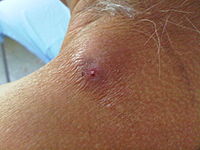
Photo from wikipedia
Goat breeding has become an important sector in Eastern Europe, with Romania and Hungary being among the major producer countries. Given the limited number of research done up-to-date concerning genetic… Click to show full abstract
Goat breeding has become an important sector in Eastern Europe, with Romania and Hungary being among the major producer countries. Given the limited number of research done up-to-date concerning genetic studies of indigenous goat breeds reared in Romania and Hungary, the current preliminary study aimed to analyze the variability of genes related to mastitis and gastrointestinal parasitism by using Kompetitive Allele Specific PCR (KASP™). We studied 52 single nucleotide polymorphisms (SNPs) belonging to 19 genes in indigenous breeds from both countries, namely Banat’s White (n = 36), Carpatina (n = 35) from Romania and Hungarian Milking (n = 79) and identified 16 polymorphic SNPs among 10 genes (PTX3, IL6, CLEC4E, IL8, IL1RN, IL15RA, TNFSF13, SOCS3, TNF and TLR3) in 150 animals. Furthermore, the diversity of the studied breeds was investigated. The PIC values ranged from 0.042 to 0.691. The mean values of observed and expected heterozygosity were 0.235 and 0.246 respectively. The highest observed heterozygosity was obtained for IL15RA g.10343904C>T in Banat’s White (0.464), IL15RA g.10354813C>T in Carpatina (0.577) and SOCS3 g.52626440T>G in Hungarian Milking (0.588). Pairwise FST values between the Romanian breeds and Romanian and Hungarian breeds were small (0.009 and 0.015), indicating the close relationship among the studied goat populations. From all the polymorphic SNPs identified, the Hungarian Milking breed showed the highest proportion of polymorphisms (100%), whereas the Carpatina breed had the lowest percentage (87.5%). The highest value of MAF was obtained for SOCS3 g.52626440T>G (0.46), IL15RA g.10343904C>T (0.47), IL15RA g.10344025C>T (0.45), and IL15RA g.10354813C>T (0.42). The 16 polymorphic SNPs identified in a panel of 150 unrelated individuals belonging to three Romanian and Hungarian indigenous goat breeds could be used in future genomic based breeding schemes as markers for genetic resistance to mastitis and gastrointestinal parasitism in goat breeds found in Eastern and Central Europe.
Journal Title: PLoS ONE
Year Published: 2018
Link to full text (if available)
Share on Social Media: Sign Up to like & get
recommendations!